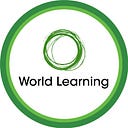This New Toolkit Will Help Expand Access to STEM Education for Students Around the World
As the need for individuals with expertise in the STEM fields continues to grow, World Learning has unveiled a free Global STEM Toolkit aimed at expanding access to a high-quality education in science, technology, engineering, and math to the next generation of problem-solvers. World Learning’s vision for the downloadable toolkit is to provide STEM resources for educators, facilitate an ongoing dialogue on STEM, and build the foundations for a global STEM learning network.
“The STEM toolkit is a really good implementation guide for educators,” said Dr. Deepa Srikantaiah, senior education and research specialist at World Learning, “I think that’s something that we saw that was missing in the resources available.”
World Learning created the toolkit, which was sponsored by Cisco, in collaboration with World Learning Algeria, The Tech Interactive, Instituto Guatemalteco Americano, Kathmandu University, the Lingua Foundation for Innovative Education, and the technology company Kano.
As educators develop and carry out STEM education programs, the toolkit offers support every step of the way, with information on performing a needs assessment, creating a curriculum, recruiting students, managing a classroom, engaging parents, conducting a program evaluation, and more.
The toolkit begins with an introduction to the philosophy of STEM education, which is rooted in exploration, teamwork, and inclusion. In addition to learning the basics of algebra, physics, chemistry, and other subject, a STEM education helps students gain a host of soft skills, such as collaboration, problem solving, and resilience, which they will need to tackle the world’s most pressing challenges.
World Learning Education Specialist Dr. Kara McBride, who worked on the toolkit, explained that STEM education moves students away from the traditional classroom model, where there is only one correct answer and making mistakes can be seen as failure. The STEM model encourages students to experiment and collaborate to find solutions and instills the notion that testing ideas that “fail” is a part of the design process. Students discover how to learn from these experiences and use this new data and knowledge as they develop their next idea.
“That’s an extremely helpful kind of attitude to have when you’re facing new problems that no one has ever grappled with before,” McBride said.
The toolkit also aims to take a truly universal and flexible approach to STEM education, providing options for educators to tailor lessons based on the needs and resources of their students and communities.
“It’s one of the few toolkits that really looks across STEM education around the world,” Srikantaiah said. “There are a lot of toolkits that are regionally focused, or country focused, or focused on a specific group of students, but this one provides general guidelines that anybody around the world can use.”
Part of this adaptability includes the teaching approach called Universal Design for Learning (UDL), which helps ensure that all students are able to receive and participate in STEM education. The toolkit introduces the basic principles of UDL to encourage teachers to create a more inclusive learning environment by considering and incorporating student needs related to disabilities, learning styles, and access to resources.
“We believe that STEM education is for everybody,” Srikantaiah said. “We want to make sure that all students are included.”
As of April 1, 2020, 573 individuals from 91 countries had downloaded World Learning’s Global STEM Toolkit. Of those, 271 identified as teachers, 44 as mentors, 56 as implementers, and 42 as students. Srikantaiah said World Learning has already received positive feedback about the toolkit from educators and is now planning to conduct a survey to gather quantitative data about how it is being used and its effectiveness.
According to Srikantaiah, the next step will be exploring ways to adapt the toolkit for online learning, since so many students are at home now because of the COVID-19 pandemic.
“Using platforms like Webex there are ways to adapt the lesson plans that are in the toolkit and to use these types of online mediums,” she said, later adding, “It’s possible as long as educators, parents and caregivers, and children have connectivity or internet access.”
Visit www.GlobalSTEMLearning.org to download the toolkit.
